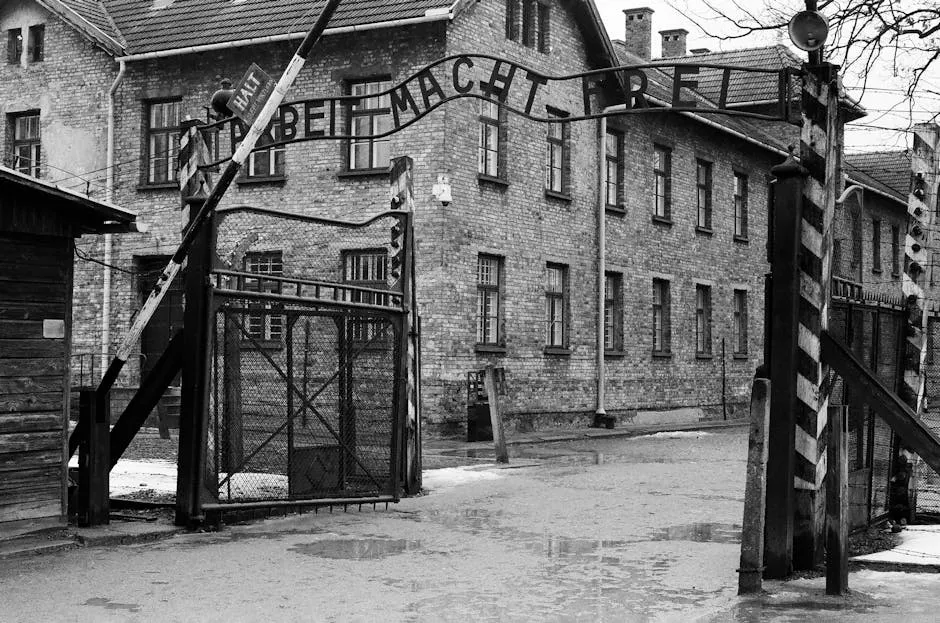
Why Did Hitler Kill Jews: Understanding the Roots of Antisemitism and the Holocaust
Introduction
Adolf Hitler’s antisemitism was a driving force behind the Holocaust, a horrific genocide targeting Jews. This dark chapter in history reveals the depths of human hatred. Understanding this context is crucial. It helps us prevent such atrocities from recurring. In this article, we will explore the reasons behind Hitler’s intense hatred of Jews.
Summary and Overview
The Holocaust resulted in the murder of approximately six million Jews. This genocide deeply impacted Jewish communities across Europe. The methods used ranged from mass shootings to gas chambers in extermination camps. As we examine this topic, we will discuss several key themes: the historical roots of antisemitism, the political motivations behind Hitler’s actions, and the lasting consequences of such hatred.

If you’re looking to dive deeper into the Holocaust and its historical implications, consider picking up The Holocaust: A New History by Laurence Rees. This book provides a comprehensive overview of the events and their impact, making it an essential read for anyone looking to understand this dark period.
Historical Context of Antisemitism
The Roots of Antisemitism in Europe
Antisemitism is not a new phenomenon; it has existed for centuries. Historically, Jews faced religious discrimination throughout Europe. This prejudice intensified during the Middle Ages, often leading to violence. By the 19th century, religious reasons gave way to racial theories. These theories portrayed Jews as fundamentally different and inferior. This shift laid the groundwork for the extreme antisemitism that surged in the 20th century.
Hitler’s Early Influences
Hitler’s early life in Austria significantly shaped his views. Growing up, he encountered a society rife with antisemitic rhetoric. Vienna’s political atmosphere, particularly during his youth, was heavily influenced by nationalist sentiments. Figures like Karl Lueger, the city’s mayor, popularized antisemitic ideas. These experiences fueled Hitler’s growing hatred, which he later channeled into his political ideology.
To further understand the atmosphere of hatred and its consequences, Night by Elie Wiesel is a powerful memoir that recounts the author’s experiences during the Holocaust, providing a deeply personal perspective on the horrors faced by millions.
Political Exploitation of Antisemitism
The Aftermath of World War I
The defeat in World War I left Germany in chaos. Many soldiers struggled to accept the loss. This created fertile ground for the ‘stab-in-the-back’ myth. Many believed that betrayal from Jews and socialists had caused their downfall. This narrative became a rallying point for German nationalists.
Economic hardships also plagued the nation. Inflation spiraled out of control, leading to widespread poverty. Political instability was rampant, with various factions vying for power. In this environment, Hitler seized the opportunity to scapegoat Jews. He framed them as the source of Germany’s troubles. This tactic fueled resentment and unified many under his leadership.

For those interested in the aftermath of these events, the Holocaust Encyclopedia by Edward Alexander is a comprehensive resource that details the events, key figures, and implications of the Holocaust, making it a valuable reference for anyone studying this period.
Rise of the Nazi Party
The Nazi Party rose to power by tapping into existing antisemitic sentiments. Hitler promised to restore Germany’s former glory. His platform included expelling Jews as a solution to national issues. Propaganda played a critical role in spreading anti-Jewish ideas.
Hitler’s speeches stirred emotions, turning public opinion against Jews. Elections became a battleground for these themes. The promise of economic recovery resonated with many voters. By exploiting antisemitism, Hitler gained significant electoral support. This paved the way for his eventual dictatorship and the implementation of horrific policies against Jews.

Ideological Foundations of Hitler’s Antisemitism
Antisemitism in Mein Kampf
Hitler’s book, Mein Kampf, serves as a window into his beliefs. He expressed deep-seated hatred for Jews throughout his writings. Key passages reveal his views on racial purity. He believed in a hierarchy of races, with Aryans at the top.
Hitler adopted social Darwinism to justify his ideology. He viewed Jews as a threat to this so-called purity. This belief laid the groundwork for the extreme measures he later enacted. By framing Jews as enemies of the state, he sought to legitimize their persecution. His rhetoric in Mein Kampf became the foundation for Nazi policies that would lead to the Holocaust.

If you’re curious about the ideological underpinnings of this dark time, check out The Nazi Doctors: Medical Killing and the Psychology of Genocide by Robert Jay Lifton. This book delves into the chilling intersection of medicine and genocide, providing insights into how professionals can become complicit in horrific acts.
Jews as Scapegoats for Societal Problems
Hitler used Jews as scapegoats for Germany’s woes. He accused them of causing economic troubles. This narrative gained traction during the financial crisis of the 1920s. Many believed Jews were responsible for the country’s inflation and unemployment. Such economic scapegoating fueled widespread resentment.
Additionally, Hitler blamed Jews for the rise of communism. He painted them as a dangerous influence on society. To him, Jews represented a threat to the Aryan race. This belief in Aryan supremacy justified his extreme actions. By portraying Jews as enemies, he united his followers against a common foe.
In Hitler’s twisted worldview, Jews embodied cultural decay. He claimed that Jewish ideas corrupted German society. This rhetoric played into existing antisemitic sentiments. It allowed Hitler to position himself as Germany’s savior. By scapegoating Jews, he diverted attention from his failures.
The consequences were catastrophic. His propaganda effectively mobilized the masses. Many accepted his claims without question. This manipulation laid the groundwork for the genocide that followed.

Implementation of Genocide
The Nuremberg Laws and State-Sponsored Persecution
The Nuremberg Laws of 1935 marked a crucial step in anti-Jewish policies. These laws stripped Jews of their German citizenship. They imposed severe restrictions on their rights. The implications were devastating, as Jews faced increasing isolation.
Gradually, anti-Jewish measures escalated. Initial policies excluded Jews from professions and public life. This legal persecution set the stage for later violence. Events like Kristallnacht showcased the brutality of the regime. It was a turning point, signaling the shift towards outright violence.

For those wanting to understand the legal framework that enabled such atrocity, The Nuremberg Trials: The Nazis and Their Crimes Against Humanity by Paul Roland offers a detailed examination of the trials that sought to bring Nazi war criminals to justice.
The Holocaust: Systematic Murder
The Holocaust represents one of history’s darkest chapters. This genocide targeted approximately six million Jews. The Nazis employed horrific extermination methods during this period. Mass shootings and gas chambers became standard practices.
Concentration and extermination camps were established across Europe. Camps like Auschwitz became infamous for their brutality. Victims faced unimaginable horrors upon arrival. Many were subjected to forced labor before their deaths.

The systematic nature of the Holocaust distinguishes it from other atrocities. It was a calculated plan to annihilate an entire population. The scale and efficiency of these methods shocked the world. Understanding this history is vital for preventing future genocides.
To gain a deeper understanding of the Holocaust’s emotional impact, I highly recommend Maus: A Survivor’s Tale by Art Spiegelman. This graphic novel tells the story of a Holocaust survivor, illustrating the horrors of the genocide through a unique and powerful narrative style.

Conclusion
In this article, we examined the roots of Hitler’s antisemitism and the horrific consequences of the Holocaust. We explored how long-standing prejudices, political instability, and Hitler’s warped ideology culminated in the systematic murder of approximately six million Jews. It’s crucial to remember this dark chapter in history. Understanding the Holocaust helps us recognize the dangers of hatred and intolerance. By learning from the past, we can combat antisemitism today. Education and awareness are essential for preventing future atrocities. Let’s remain vigilant against hatred in all its forms.

To reflect on the importance of remembrance, consider lighting a Holocaust Memorial Candle. It serves as a poignant reminder of the lives lost and the importance of standing against hatred.
FAQs
What were the main reasons for Hitler’s hatred of Jews?
Hitler’s hatred stemmed from historical, social, and political factors. Antisemitism was deeply rooted in European culture. After World War I, many Germans sought scapegoats for their troubles. Hitler exploited this sentiment, blaming Jews for Germany’s defeat and economic woes. His beliefs were influenced by nationalist ideologies and twisted racial theories.
How many Jews were killed in the Holocaust?
Approximately six million Jews were murdered during the Holocaust. The Nazis employed brutal methods, including mass shootings and gas chambers. This genocide targeted about two-thirds of Europe’s Jewish population, devastating communities and families across the continent.
What role did propaganda play in Nazi Germany?
Propaganda was a powerful tool for the Nazis. It spread antisemitic ideas and shaped public opinion. The regime used media, rallies, and films to dehumanize Jews. This created an environment where violence against Jews became acceptable. Propaganda helped galvanize support for the Nazis and their horrific policies.
Were other groups also targeted during the Holocaust?
While Jews were the primary victims, other groups faced severe persecution too. The Nazis targeted the Roma community, often referring to them as “Gypsies.” Historians estimate that about 500,000 Roma perished during the Holocaust. People with disabilities were also victims of Nazi ideology. The regime implemented the T-4 program, which led to the systematic murder of individuals deemed “unfit.” This program killed approximately 250,000 people with physical and mental disabilities. Political dissidents, including communists and socialists, faced brutal crackdowns as well. Many were imprisoned or executed for opposing Nazi policies. The Nazis viewed these groups as threats to their regime and sought to eliminate them. The Holocaust was not just a campaign against Jews; it was a broader assault on anyone considered undesirable by the Nazi regime.
How can we prevent future genocides?
Preventing future genocides requires a multi-faceted approach. Education plays a crucial role in fostering understanding and empathy. By teaching about the Holocaust and its lessons, we can combat hate before it escalates. Awareness is also essential. Communities must remain vigilant against signs of discrimination. Engaging in activism helps promote tolerance and acceptance among diverse groups. Supporting organizations dedicated to human rights can amplify our efforts. Collective action can create a powerful voice against bigotry and injustice. History teaches us that silence can lead to complicity. We must challenge hate wherever we see it, ensuring that the horrors of the past are never repeated.
Please let us know what you think about our content by leaving a comment down below!
Thank you for reading till here 🙂
All images from Pexels




